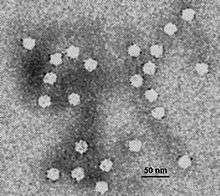Buoyant density centrifugation

Buoyant density centrifugation (also isopycnic centrifugation) uses the concept of buoyancy to separate molecules in solution.
Implementation
Usually a caesium chloride (CsCl) solution is used, but in the general case it's usually approximately the same density as the molecules that are to be centrifuged. The sample is put on top of the solution, and then the tube is spun at a very high speed for an extended time, at times lasting days. The CsCl molecules become densely packed toward the bottom, so even layers of different densities form. Since the original solution was approximately the same density, they go to a level where their density and the CsCl density are the same, to which they form a sharp, distinctive band.
Isotope separation
This method very sharply separates molecules, and is so sharp that it can even separate different molecular isotopes from one another.
DNA separation
Buoyant density of majority of DNA is 1.7g/cm3 which is equal to density of 6M CsCl solution. Buoyant density of DNA changes with its GC content.
See also
References
Further reading
- Schildkraut, Carl L.; Marmur, Julius; Doty, Paul (1962). "Determination of the base composition of deoxyribonucleic acid from its buoyant density in CsCl". Journal of Molecular Biology. 4 (6): 430–443. doi:10.1016/S0022-2836(62)80100-4. ISSN 0022-2836.
- James Greene (25 June 1998). Recombinant DNA Principles and Methodologies. CRC Press. pp. 278–. ISBN 978-0-8247-9989-2.